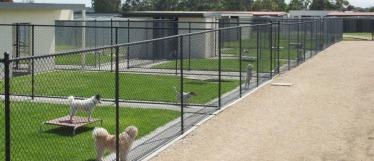 Boarding can be a stressful experience for dogs and humans. Being prepared and aware of some of the options and concerns can really help make it a reasonable experience for both yourself and your dog.
Boarding can be a stressful experience for dogs and humans. Being prepared and aware of some of the options and concerns can really help make it a reasonable experience for both yourself and your dog.
So what can you do to ensure a pleasant stay?
1 – Have a list of your concerns to ask the business. These should include things like:
- Veterinary information and what steps the facility will take in the event of an emergency
- Insurance information for the boarding facility
- Where will the dog be kept through the day/night?
- What exercise the dog will get?
- How many and what kind of dogs (if any) will be interacting with yours?
- What kind of supervision will the interactions will get?
- What inoculations are required?
- What do they feed? Some kennels will insist on feeding their own food while others want you to maintain your dog’s current diet.
- How big will your dog’s area be?
- Will they have an individual area?
2 – Bring some things that will help your dog feel at home. These may include their favourite toys, beds and chews. If you have a puppy or a dog who is likely to stress, the things you include should not be potential dangers if chewed.
3 – Pick the right type of boarding facility for your dog. There are a few main styles which include:
– in home where you send your dog to someone’s home
– in home where someone else moves into your home
– kennel environment which can include a daycare
What dogs should go where?
In home:
– puppies – puppies can get put off easily by big, noisy environments. Young puppies especially can have life altering experiences if they are put into overwhelming kennel situations. The noise of the other dogs, unfamiliar environment and people can be really hard for a puppy to deal with.
– senior dogs – old dogs who are used to quiet environments may also find a kennel environment hard to deal with. Physically, they may find the cold, hard floor to be too much, especially if they suffer form arthritis.
Kennel:
– Dogs who require a lot of exercise can benefit from an environment that provides stimulation through daycare or board & train programs. Extra exercise and fun through the day will help them relax through the evening.
4 – Be sure to include a list of instructions such as medications, dietary or social restrictions, as well as anything else the staff should know about your dog.
5 – Try overnight first. Set your dog up with a single day/night stay prior to your 2-week vacation to help them acclimate to the new environment. Let the staff know that you would like feedback on how the dog made out.
6 – Book early! Don’t wait until the last minute to plan your dog’s stay. This will lead to a rushed decision that may be the wrong one. Doing your research and planning their boarding well in advance will ensure you feel confident about the decision you’ve made for their stay.
Enjoy your vacation!

